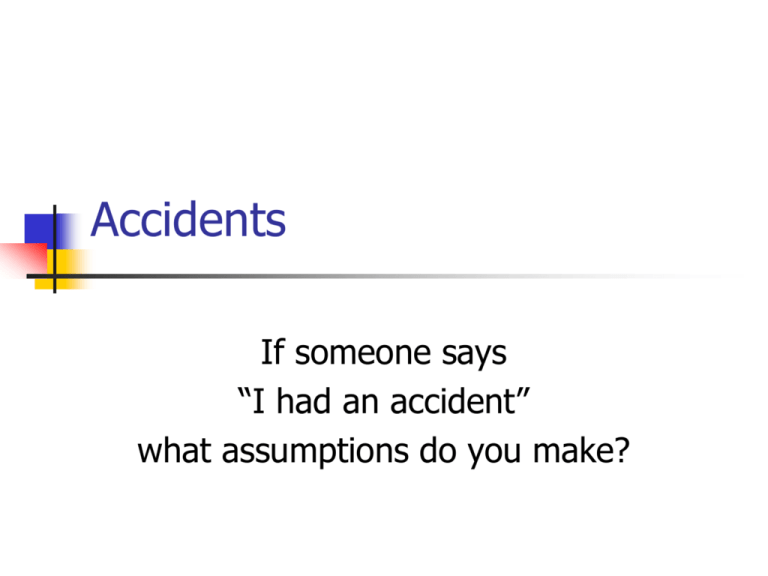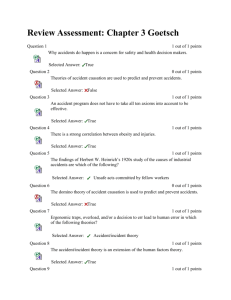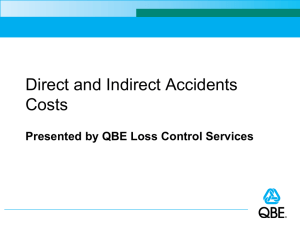Accidents
advertisement

Accidents If someone says “I had an accident” what assumptions do you make? What is an accident? In the OSH setting Unintended and untoward event Unplanned, unexpected event, in a sequence of events; it results in physical harm, injury or disease to an individual, damage to property, a near miss, a loss, or any combination of these effects A failure of a person to cope with the true situation presented to him. Who cares? Victim Governments Researchers Employers Engineers, organisational psychologists, socioligists, quality controllers, high risk industries Safety managers and other OSH professionals Accident Prevention Hazard Identification Risk Assessment Controls Tools for Occupational Health and Safety Management OSH reasons for collecting accident information Analysis of past accidents, patterns and trends Accident investigation Accident notification requirements (the law) Insurance company requirements – claims management Allocation of blame Collecting information = accident investigation Accident Investigation Purpose Methods vary To prevent accidents happening in the future To determine the immediate (proximate) AND the underlying (distal or root) causes of accidents Systematic look at all contributing factors Outcomes Focus on the root cause as opposed to the consequences or a scapegoat Conclusions linked to what actually happened A list of recommendations for change OSH law Injury and illness prevention is a legal requirement Accident reporting to a competent authority is a legal requirement (subject to T&C) Accident investigation is not a legal requirement Analysis of organisational data is not a legal requirement The cost of work-related accidents 5,500 people killed annually in Europe 60 people killed annually in Ireland 500 million working days lost in EU in 1998 as a result of accidents 4.7m accidents resulted in absences of more than three days in EU in 1998 Direct costs of workplace accidents Employee lost time Medical and hospital costs Compensation and liability claims Legal costs Insurance costs Replacement costs (equipment, products, personnel) Indirect costs of workplace accidents Cost of time lost by other employees who stop work Cost of time lost by supervisors Cost of first-aider time Cost of injury to equipment or spoil to materials Cost of interference with production Cost die to ensuing loss of profit Overhead cost of injured employee Administrative costs Accident Statistics National and international Classification schemes Local Harmonisation: ESAW, ILO Recording procedures A single major accident can dramatically alter accident statistics Accident Causation Models Heinrich’s domino model (1920s) Bird’s loss control model (1960s) Hale and Hale’s model (1971) Reason’s organisational accidents model (1990s) There is NO universally accepted model Causes are generally seen to be at individual level or organisational level (work activity, working environment and organisational factors) Accident Causation Accidents usually arise from a particular combination of circumstances, not from a single cause (but it is often necessary to attribute a principal cause) Accidents often preceded by near misses No one causitive factor is implicated in all accidents There are wide variations in the consequences of similar accidents/incidents BIRD Accident Triangle (1969) Major injury 1 Minor injury 10 30 600 Damage only No injury or damage Accident Investigation Tools MES – multilinear events sequencing ECFC – Events and causal factors charting FTA – fault tree analysis MORT – management oversight and risk tree STEP – Sequentially timed events plotting SCAT – Systemic causal analysis technique CMT – causal tree method WAIT – Work Accidents Investigation Technique …and many more… Accident Research Accident causation models been developed since early 20th C In the past two decades accident research has focused on major accident analysis Emphasis is shifting towards ordinary and frequent accidents Occupational Safety and Health in Ireland Wide variety of work situations Busy OSH is not always a priority OSH solutions need to be: Easily applicable - not over-technical Practical and user-friendly Clearly defined with minimum ambiguity




